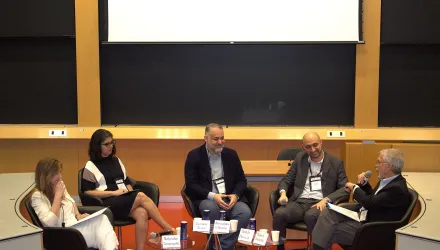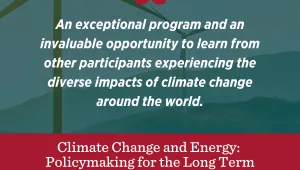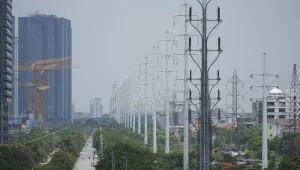For a Breakthrough for Troubled Negotiations
With the gap between developed and developing nations remaining unclosed, post-Kyoto Protocol negotiations have run into rough waters: Developing countries insist that developed countries be committed to more ambitious targets for the second phase of the Kyoto Protocol and provide large amounts of financial or technological assistance to developing countries, while developed countries propose that financial and technological support be balanced with developing countries’ mitigation actions and measurement, reporting, and verification (MRV).
- In order to solve climate change issues, the following three conditions should be met: Given future forecasts of greenhouse-gas (GHG) emissions induced by human activity, emission mitigation on the part of developing countries is indispensable.
- The Kyoto Protocol, which only imposes legally-binding reduction targets upon developed countries (and from which the United States has withdrawn), cannot provide an effective solution to climate change issues; therefore, a new imaginative international framework that promotes emission mitigation on the part of both developed and developing countries is required.
- For a period of time before graduation from the non–Annex I category, developing countries must be provided the resources that they are short of for the implementation of mitigation measures, on the condition that they accept a robust MRV process.
With regard to developing a new international framework, developed countries should acknowledge how grave the consequences would be to easily give in to a Kyoto extension. Merely extending the Kyoto Protocol would surely delay mitigation actions on the part of developing countries and discourage the U.S. from making serious efforts to reduce its large energy consumption. In other words, no country should end up being a "climate-killer" in its attempts to avoid being called a "Kyoto-killer."
I have made a policy proposal1 for a "Commit and Act"–based framework, to replace the Kyoto Protocol. This is a new international framework that takes a bottom-up approach embracing legally-binding commitments to implement domestic mitigation policies and measures, by all major emitter countries. However, any negotiations on a new framework are projected to become time-consuming processes. Until a final agreement can be reached, it would be worthwhile to consider developing a scheme to promote bilateral and/or regional cooperation for continued mitigation actions and the facilitation of UN negotiations from the sidelines. The task of building a new international framework in place of the Kyoto Protocol would become easier if based on bilateral and/or regional mitigation cooperation. If the Conference of the Parties (COP) should decide in Cancun that, acknowledging that they serve the purpose of the United Nations Framework Convention on Climate Change (UNFCCC), bilateral and/or regional cooperation should be encouraged, it is certain that major developed countries, including Japan and the European Union (EU), would be in a rush to start talks with developing countries with large mitigation potential about what projects to implement for joint mitigation actions, in pursuit of securing a lucrative market for their technology and products.
Bilateral Offset Crediting Mechanism
A bilateral offset crediting mechanism is an example of a bilateral and/or regional scheme for cooperation. The Government of Japan took up the policy proposal I made last December2 and has explored the possibilities for this type of cooperation, especially with Asian developing countries. This mechanism aims to achieve substantial GHG mitigation through industrialized countries providing environmental technology or facilities, along with the necessary financing, to developing countries that are willing to address climate-change issues.
- The Clean Development Mechanism (CDM), stipulated in the current Kyoto Protocol, is a similar mechanism. According to some, however, the CDM has several flaws: The validation process requires an unreasonably long time.
- Because of the so-called additionality criteria, energy-conservation projects become very difficult to be approved.
- Nuclear power generation and carbon capture and sequestration (CCS), both of which could contribute greatly to global climate change measures, are not covered for political reasons.
- The number of countries benefitting from the CDM scheme has been very limited. Around half of all CDM projects are located in China.
Bilateral offset crediting mechanisms could overcome these shortcomings of the CDM. With more prompt and simplified procedures, they promise to more substantially advance climate change measures for mitigation.
Bilateral crediting schemes can be largely categorized into two types, namely, project-based and sector-based mechanisms. In the project-based crediting mechanism (PBCM), reductions achieved in bilaterally-agreed mitigation projects constitute the basis for credits. By deploying technologies internationally acknowledged to be of top-level efficiency, the mechanism leads to the substantial reduction of emissions from the baseline. The flexible design of PBCMs could surmount the above-mentioned problems of CDMs by allowing credits to be issued based on project approval standards and MRV rules, which are to be bilaterally agreed upon on a government-to-government basis.
On the other hand, given the strong opposition from developing countries resisting national mitigation targets, the sectoral crediting mechanism (SCM) seeks to establish baselines for specific sectors, beginning with those that can be agreed upon. Reductions in excess of the target baseline generate credits and constitute a no-lose scheme for developing countries.
A detailed comparison of the two mechanisms follows:
| PBCM | SCM | |
| Actor | Project implementer | Entire sector or emitting sources of a certain scale in covered sector |
| Baseline setting method | Business as usual (BAU). Methodology based on existing CDM. | Benchmarking. Higher standards than BAU. |
| Uncertainty of credits issued | Low because the details of the project implemented are identified. | High because the data collection is difficult, and various elements impact emissions |
| Acquisition of credits (actor with mitigation incentive) |
Project implementer | Developing country government or trade union in covered sector |
| Accelerated mitigation activities | High chance of implementation of relatively costly mitigation actions, because credit income for project implementers is relatively secure. | Widespread mitigation actions through policy because governments will be motivated to reduce emissions. |
| Technological transfer | Transfer of technologies with high barriers, including cost | Dissemination of existing technology |
The availability of various offset crediting mechanisms could increase options for developing countries, but in reality, diverse problems arise when both mechanisms operate at the same time. First, in order to be accepted in the post-Kyoto framework, credit values must be measured based on common criteria. Therefore, it would be necessary to develop MRV rules that could be accepted by the majority of parties concerned. Second, the intentions or purposes of developed countries in support of different types of mechanisms would confuse developing country governments. For example, Japan supports the PBCM in order to contribute to substantive emissions mitigation by implementing projects employing high-level, low-carbon technologies, whereas the EU seeks to promote the SCM, in hope of expanding the carbon market and establishing an economy-wide emissions cap on developing countries in the future. The possible structure of a post-Kyoto framework might be suggested in the process of finding solutions to the problems arising in harmonizing different crediting mechanisms.
Going Beyond Bilateral Offset Crediting Mechanism toward NAMA-Assistance
This section proposes that developed countries’ assistance to developing countries should be expanded beyond bilateral offset crediting mechanisms to cover a package of a broad range of mitigation actions by developing countries known as Nationally Appropriate Mitigation Actions (NAMAs). Emission-mitigation actions based on policies and measures in the household, office, and transport sectors, for example, can be covered. Although a sense of obligation towards the domestic implementation of NAMA prevails among some Asian and South American nations with proactive attitudes towards coping with climate change issues, these nations often face a shortage of funds. Some developing country parties have a strong interest in creating NAMA-based credits or to implement NAMAs with the profits earned from selling credits generated in bilateral offset-crediting mechanisms. However, given the diversity of mitigation actions considered to be NAMAs, its potential for awarding credits requires further discussion. Also, the baseline-setting methodology, the uncertainty of the amount of credits generated, the incentive created for relevant parties, and the likelihood of technological transfer differ according to the mitigation action.
- For example, a mitigation action to establish a low-carbon-oriented transportation system in the transport sector of a developing country could work as follows: First, mitigation measures such as transferring know-how for collecting and processing the data necessary for a policy proposal, capacity-building in terms of fostering human resources for policy planning, providing know-how for implementing automobile-fuel-regulation policies, building a subway system, maintaining and improving highways, and introducing a traffic control system, as well as establishing the inventory required for international MRV and the MRV system itself, are all included in a single package.
- Bilateral (or multilateral) consultation is conducted with a developed country, and when agreement is reached, the NAMA-package for transport policy including the essences described in (1) is documented and publicly announced, followed by the conclusion of a bilateral pledge. The legal document may be compiled according to the legal systems of the parties concerned, but the jurisdiction of dispute settlement should preferably be specified. Furthermore, if this cooperation model can be formally incorporated in the post-Kyoto framework to be agreed upon, developing countries can register their mitigation actions in their national inventories and pledge to implement them, and developed countries can include the registered mitigation actions of developing countries, which they have agreed to support, in their own mitigation commitment. By registering all bilateral and regional cooperation, global estimates can be possible.
- If a project is suitable for funding by a crediting scheme in the process of developing a NAMA, the developing country should select whether to adopt an SCM or a PBCM, based on a comparison of the advantages and disadvantages of the SCM and the PBCM, and in accordance with national circumstances and policy. For example, a subway construction project would be limited to certain cities and therefore different mechanisms can be chosen by region — crediting can be based on SCM in some regions and be project-based in others. Time and energy should not be wasted upon trying to decide between SCMs and PBCMs as the ruling mechanism or upon searching for a compromise; it would be a more promising solution to leave the decision open for the developing country to make.
- Once developing countries have chosen a scheme, they must pledge not to redundantly use the credits generated or reduced emissions certified in other schemes. This pledge could be included in the bilateral agreement described in (2), but in light of the character of the issue, it should preferably be internationally declared by the developing country.
Diverse Forms of Assistance
Support for developing countries can be provided in two forms, namely, offset crediting mechanisms and direct support based on public funds. An offset crediting mechanism is a scheme directly linked to GHG mitigation and effectively works as an incentive for private entities. The downside of this mechanism is that credits are generated only after the mitigation actions, for which funds must initially be procured, and that the scheme is not able to deal with the various bottlenecks (MRV systems and developing human resources) approached in the process of project design. In contrast to offset crediting mechanisms, direct support allows funds to be allocated not only for mitigation but also for adaptation, technology development not leading to emission reductions in the short-term, capacity building (including human resources development), feasibility studies, and policy consulting.
Based on these features, direct support is beneficial in three dimensions: Firstly, it can allocate funds to climate-change measures that require a long-term perspective, such as technology development and capacity building, instead of being caught up in immediate reductions. Secondly, it can avoid the negative effects associated with support for quantifiable emission reductions, which tends to be extended to emerging countries with high emission levels but delayed for developing countries undergoing slower economic development. Thirdly, by combining direct support with an offset crediting mechanism, plans that could not be formulated into projects for various reasons can be realized. In addition, unlike mechanisms such as offset crediting mechanisms, in which emission reductions are sold in the market, direct support measures do not require MRV of reductions, but call for governance to make sure that the funds provided were used for climate change measures and for cost-efficient mitigation measures — that they were not used to aid inefficient production sites.
In a NAMA-support program, the tools employed can be altered in accordance with the differences in the measures covered or the level of economic development.
[Phase 1] Direct support-oriented
This category mainly comprises less developed countries, which are intrinsically not large emitters and therefore are not suitable for offset-crediting-mechanism-based support. Developing countries covered in this group should not be incorporated into a financial product market but should be given the direct support that will help their real development. Depending on the wishes of the country, offset crediting-mechanism-based support can also be provided.
[Phase II] Offset crediting mechanism-oriented
Developing countries not classified under Phase I are covered in this phase. Direct support should be prioritized for Phase I countries and minimized for Phase II countries. Having fostered a certain level of capacity to implement mitigation measures, Phase II countries should mainly receive offset crediting mechanism-based support which can provide strong incentive towards mitigation efforts. However, when initial investment costs are the bottleneck for implementing mitigation actions, government financial agencies should offer low-interest loans.
[Phase III] Limited to soft support; not accompanied by financial aid
Phase II countries that have become particularly developed and that voluntarily choose to implement mitigation actions without support from developed countries are covered in Phase III. As stipulated in the Copenhagen Accord, mitigation actions that receive support are targets of international MRV. Therefore, countries preferring not to apply international MRV are likely to select this phase, in which human capacity building, standardization, and establishing technological standards and other soft support can be provided.
The decision on which phase should be applied to each developing country can either be left to be made individually by each country or be made according to specific criteria, such as per capita GDP. However, the latter entails risks of creating difficulties in agreeing on common criteria; therefore, the realistic method would be for developing countries to choose independently. The three phases do not intend to clearly divide developing countries into three groups but to conceptually show the correlation between the level of development and approach towards assistance. The important point is that approaches towards support shift gradually from "direct support-oriented" assistance to "offset crediting mechanism-oriented" assistance and finally to assistance "limited to soft support, not accompanied by financial aid" according to the level of development. The categorization between developed and developing countries should not be fixed in disregard of the development level of developing countries, and the scheme should be carefully designed so that developing countries are not entitled to permanent assistance.
If this scheme proves successful, it could be expected to present a model for bilateral or regional cooperation, and be included in the post-Kyoto framework negotiations in the UN to be incorporated as an important potential policy component.
1 See http://www.21ppi.org/english/pdf/071112.pdf
2 For the proposal, see http://www.21ppi.org/pdf/thesis/091211.pdf (only in Japanese) Akihiro
Akihiro Sawa is Leader of the 21st Century Institute's Project on Post-Kyoto International Framework and former Professor at the University of Tokyo's Research Center for Advanced Science and Technology.
Viewpoints present policy proposals, considered opinions, and commentary by distinguished policymakers, leaders from business and nongovernmental organizations, and scholars. The Harvard Project on Climate Agreements does not advocate any specific climate-change policy proposals. Statements and views expressed in Viewpoints are solely those of the authors and do not imply endorsement by Harvard University, the Harvard Kennedy School, or the Harvard Project on Climate Agreements.
Sawa, Akihiro. “Towards a Breakthrough for Deadlocked Climate Change Negotiations.” Harvard Project on Climate Agreements, Belfer Center, December 2010



